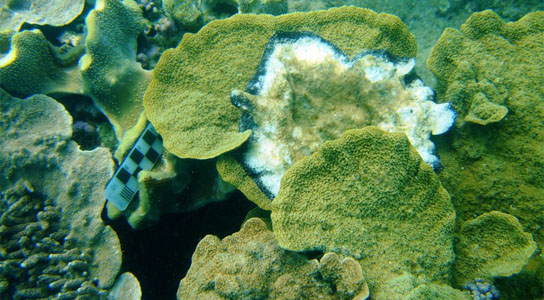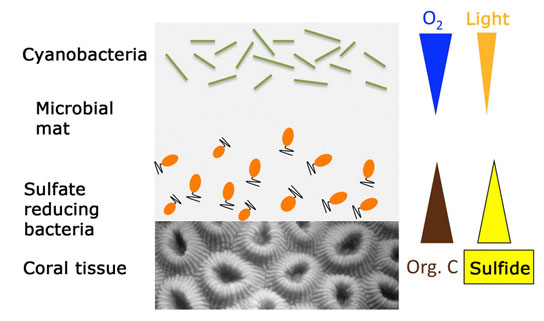
The Great Barrier Reef is under attack by a disease and new data shows that the Black Band Disease can migrate at a rate fast enough to kill entire coral colonies and put the population size of many coral species at risk for drastic decline.
Researchers of the Max Planck Institute for Marine Microbiology along with Australian colleagues, have examined corals from the Great Barrier Reef affected by the Black Band Disease and identified the critical parameters that allow this prevalent disease to cause wide mortality of corals around the world. Corals infected with the Black Band show a characteristic appearance of healthy tissue displaced by a dark front, the so-called Black Band, which leaves the white limestone skeleton of the coral animal exposed. The dark front is commonly one to two centimeters broad and consists of a complex microbial community among which there are phototrophic cyanobacteria, sulfur-oxidizing bacteria, and sulfate-reducing microorganisms. The corals and their endosymbiotic algae are struck by three stress factors at once: toxic sulfide, anoxia, and a low pH at the boundary of the bacterial mat and the coral tissue.

The scientists investigated the tissue lesions with microsensors for oxygen, sulfide, and pH. These microprobes have a tip diameter in the micrometer range and allow the scientists to measure highly resolved depth profiles in the coral tissue. They identified big differences between infected tissue and tissue in the preliminary stage of the disease: “In diseased coral tissue two zones develop: A phototrophic zone at the top in which the cyanobacteria produce oxygen and a lower anoxic zone in which the bacteria degrade the necrotic coral tissue. Sulfide is formed in the degradation process,” Martin Glas of the Max Planck Institute in Bremen explains the results. “In tissue that is only slightly infected the zonation is not nearly that strong. Usually, we could not detect sulfide, and oxygen penetrated deep into the bacterial mat.”
At the front of the dark zone the conditions are particularly detrimental for the corals. The increased sulfide concentration around the necrosing tissue and the resulting decrease in oxygen leads to the spreading of the lesions to the surrounding, healthy tissue; a positive feedback that causes rapid migration of the Black Band Disease.

“We assume that the biogeochemical conditions at the surface of the coral tissue are responsible for the fast spreading of the disease. The higher the sulfide concentrations are and the less oxygen there is, the faster the dark front is migrating,” Martin Glas describes the causes for the origin and the high virulence of the disease. So far, at least, the scientists have not identified a pathogen that could be responsible for the necrosis of the coral tissue. “Our measurements show that the Black Band Disease can migrate at one centimeter per day in the summer months. At this speed, within a very short time, whole coral colonies can die and the population size of many coral species on the reef and number of species in the reef can drastically decline,” says Martin Glas.
For several years, David Bourne of the Australian Institute of Marine Science in Townsville and his colleague Yui Sato have been performing monitoring programs on the condition of coral reefs in which they also examined the coral diseases in the Great Barrier Reef. David Bourne says: „Presumably the Black Band Disease is one of the most frequently reported diseases in tropical reefs. One major cause is the seasonally high water temperature. Thus, results from this study allow us to understand at the micro-scale how the environmental conditions and the complex microbial community interact to result in the onset and progression of this coral disease.”
Is there any cure for the reefs? “If the temperature decreases in winter the disease is stagnant. However, with increasing frequency the disease recurs in the next year. The bare coral skeleton can be overgrown by new polyps. But this may take many years,” as Yui Sato of the James Cook University states.